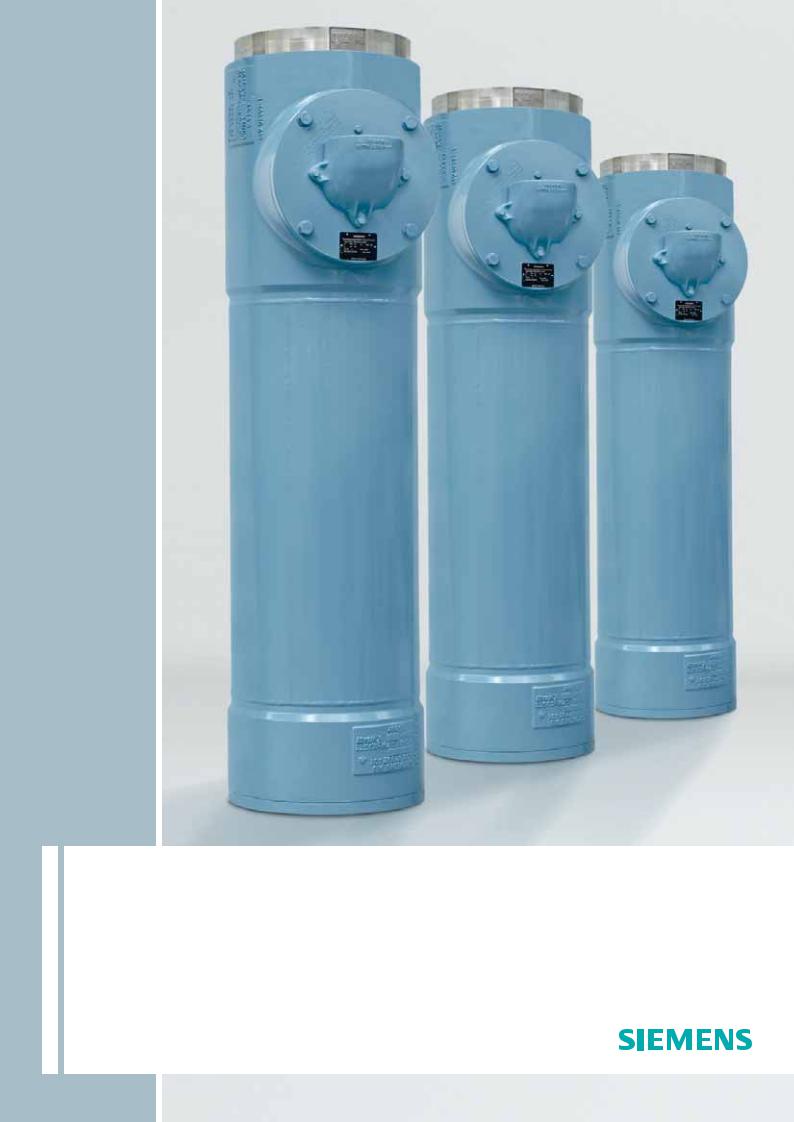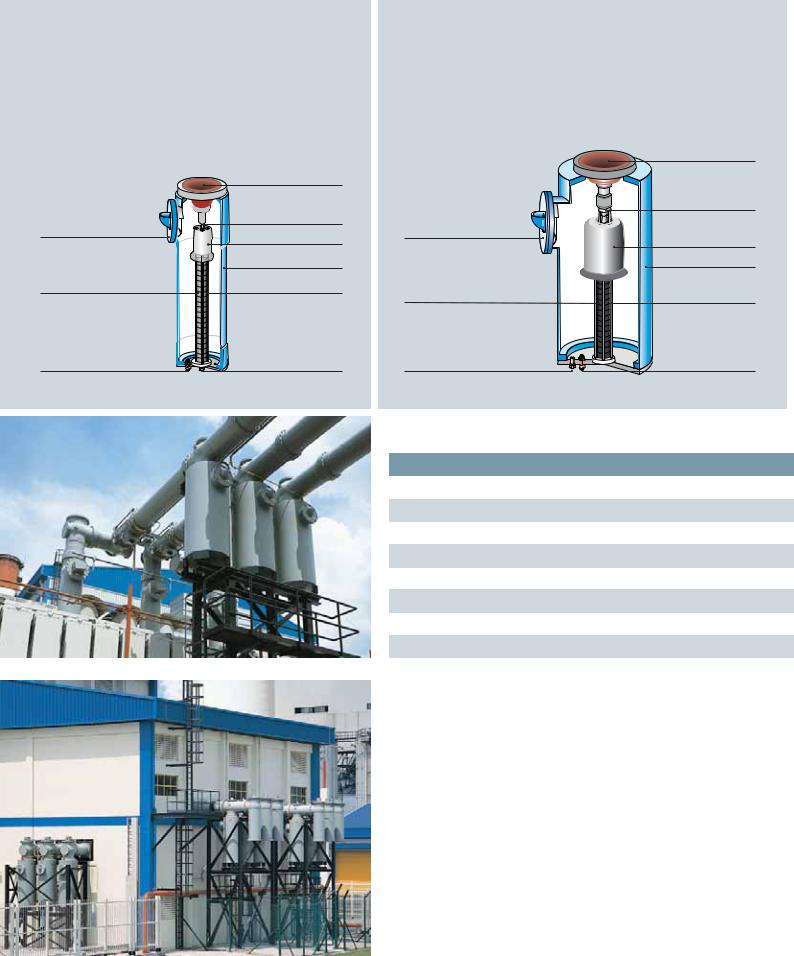Siemens 3ES User Manual

3ES Surge Arrester
Metal-enclosed, SF6-insulated for High Voltage Systems up to 800 kV
Answers for energy.

Perfect Fit
Based on more than 80 years of experience in the world market of surge arresters and a comprehensive portfolio of products for installations rated up to 800 kV, Siemens has become the preferred supplier of HV surge arrester technology for utilities, industrial companies and equipment manufacturers as well as public institutions and consultancies.
Whatever your needs, our surge arresters have a perfect fit in any installation. Sized to demand at competitive costs, they combine the right performance with maximum reliability over a long service live. From overall trouble-free operation to uncompromising safety demands, such as for gas-insulated switchgear – our 3ES series of surge arrester has a history of successful applications throughout the world.
Maximum protection
Siemens gas-insulated, metal-enclosed arresters (GIS arresters) provide maximum protection for gasinsulated switchgear (GIS) and transformers. The reasons are twofold: On the one hand, GIS arresters can be installed very close to the object to be protected, which is important wherever they are fed by long cables, for instance. In this way, over-voltages caused by traveling waves can effectively be minimized. On the other hand, the low self-inductance of GIS arresters provides the best conceivable protection against high rate-of-rise voltages, which
are particularly critical for gas-insulated equipment.
Service experience since 1974
The first Siemens GIS arresters were supplied in 1974. Since then, they have been designed for an extremely wide range of different applications, with installations worldwide. Today, Siemens has extensive know-how in GIS arrester technology, ensuring optimum operating characteristics and highest reliability.
Single-phase and three-phase configurations
Siemens offers two different series of GIS arresters. The 3ES2-D, 3ES2-E and 3ES5-H models all feature an electrical and mechanical single-column design. The same design is also available for three-phase configurations (i. e. 3ES5-C three phases per vessel).
2

Gas and electrical monitoring for GIS arrester
In contrast, the 3ES9-J series has a three-column mechanical and single-column electrical design, which results in a meandering low-inductance current path and reduces the overall length of the arresters.
Ultimate safety
Naturally, all Siemens GIS surge arresters are equipped with pressure-relief safety diaphragms and comply with international standards, such as IEC 60517. By careful choice of materials and paint structure, all Siemens GIS arresters are suitable for outdoor installation.
Arrester monitoring
Every GIS surge arrester from Siemens provides a gas connection. This permits the arrester to be incorporated in an existing gas monitoring system. Alternatively, a separate arrester gas monitor can be provided. The earthed end of each individual arrester phase is routed out of the tank through an insulated bushing which can be used to connect monitoring devices, such as surge counters, telltale spark gaps or leakage current meters.
Versatile connection to any GIS system
Siemens GIS arresters permit versatile connection to any GIS system. Bushings may be of the standard
design or customer specific. Gas-to-gas type bushings as well as gas-to-oil type bushings for connection
to transformers are available. In addition to standard connection flanges, special flanges or auxiliary adapter flanges can also be designed, manufactured and supplied according to customer requirements.
Simple and economical start-up
Our GIS arresters minimize the time and labor required for commissioning. The internal mechanical design of the arresters eliminates the need for transportation retainers and opening the tank, which is normally undesirable. However, an internal disconnecting piece is provided, permitting dielectric tests to be performed on the GIS without having to remove the arrester. Depending on the customer’s requirements, GIS arresters can be installed in suspended, upright or horizontal positions.
Maintenance-free
Siemens GIS arresters are virtually maintenance-free. Apart from the usual reading of optional electrical monitoring devices and the gas monitor, only the gas humidity has to be checked after ten years, and only the filter material within the tank has to be changed after twenty years of service.
3

3ES2-D/E |
3ES5-F/G/L |
single-phase |
single-phase |
(diameter 396 mm) |
(diameter 710 mm) |
|
|
|
SF6-SF6-bushing |
|
SF6-SF6-bushing |
|
(Oil-SF6-bushing |
|
|
on request) |
|
|
(Oil-SF6-bushing |
|
|
|
on request) |
|
|
Access cover with |
|
Access cover with |
Spring contact |
pressure relief |
Spring contact |
pressure relief |
|
device and filter |
Grading hood |
device and filter |
Grading hood |
|
|
||
|
Enclosure |
|
Enclosure |
Metal-oxide resistors |
Supporting rods |
Metal-oxide resistors |
Supporting rods |
|
|
||
|
Gas pressure / |
|
Gas pressure / |
Electrical monitoring |
density |
Electrical monitoring |
density |
devices |
monitoring |
devices |
monitoring |
|
Type |
|
|
Highest voltage for equipment Um |
[kV] |
|
Max. rated voltage |
[kV] |
|
Max. nominal discharge current |
[kA] |
|
Max. line discharge class |
|
|
Max. thermal energy absorbing capability (per kV of Ur) |
[kJ/kV] |
|
Max. long duration current impulse, 2 ms |
[A] |
|
Max. height |
[mm] |
|
Max. weight |
[kg] |
|
|
|
GIS arresters connected to a 420 kV GIS busbar
4
